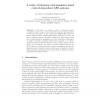Free Online Productivity Tools
i2Speak
i2Symbol
i2OCR
iTex2Img
iWeb2Print
iWeb2Shot
i2Type
iPdf2Split
iPdf2Merge
i2Bopomofo
i2Arabic
i2Style
i2Image
i2PDF
iLatex2Rtf
Sci2ools
MLMI
2007
Springer
2007
Springer
A Study of Phoneme and Grapheme Based Context-Dependent ASR Systems
In this paper we present a study of automatic speech recognition systems using context-dependent phonemes and graphemes as sub-word units based on the conventional HMM/GMM system as well as tandem system. Experimental studies conducted on three different continuous speech recognition tasks show that systems using only context-dependent graphemes can yield competitive performance on small to medium vocabulary tasks when compared to a contextdependent phoneme-based automatic speech recognition system. In particular, we demonstrate the utility of tandem features that use an MLP trained to estimate phoneme posterior probabilities in improving grapheme based recognition system performance by implicitly incorporating phonemic knowledge into the system without having to define a phonetically transcribed lexicon.
Automatic Speech Recognition | Machine Learning | MLMI 2007 | Speech Recognition System | Speech Recognition Tasks |
| Added | 08 Jun 2010 |
| Updated | 08 Jun 2010 |
| Type | Conference |
| Year | 2007 |
| Where | MLMI |
| Authors | John Dines, Mathew Magimai-Doss |
Comments (0)

